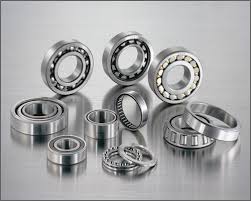The Role of Contact Angle in the Performance of Taper Roller Bearings
When you take apart any machine a car wheel, a lathe, or a gearbox you’ll usually find a small but...

When you take apart any machine a car wheel, a lathe, or a gearbox you’ll usually find a small but critical part holding things together: the bearing. Among all bearing types, taper roller bearing India stand out because they handle both radial and axial loads with ease.
But here’s the thing their performance depends a lot on a small geometric detail most people overlook: the contact angle.
What the Contact Angle Actually Means
Let’s keep it simple. Imagine a cone rolling between two metal tracks one on the inside (the inner race) and one on the outside (the outer race). The roller touches both these tracks at an angle. The line drawn through those contact points, when extended, meets the centreline of the bearing.
That line forms what we call the contact angle. It’s not just a number on a design sheet; it decides how the bearing divides and carries the forces acting on it. A small shift in this angle can change how the entire bearing behaves under load. Today, Taper roller bearings India are widely used in many automotive, rail, and heavy machinery sectors.
How the Contact Angle Affects Bearing Loads
In every rotating part, there are two types of loads radial (sideways) and axial (along the shaft). The contact angle determines how the bearing splits these two forces.
- Smaller contact angles (say 10°–20°) mean the bearing is better for radial loads. It doesn’t like too much axial push.
- Larger contact angles (25°–40° or more) can handle stronger axial loads, but they create more friction.
That’s why the angle can’t be random its chosen based on where and how the bearing will be used. For example, a car wheel needs a higher contact angle because of the sideways forces when turning, while an electric motor might need a smaller one for speed.
Performance Changes with Contact Angle
Let’s look at what happens when the contact angle changes
- Load Capacity
A bigger angle gives the bearing more strength to take on axial loads. The pressure spreads evenly along the roller. If the angle is too small, the load path shifts, and parts of the roller get overstressed — leading to early wear or pitting.
- Friction and Heat
With a large contact angle, the rollers experience more sliding. This adds friction and generates extra heat. Lubrication becomes more critical in such cases. Bearings designed for high-angle operation usually use special greases or oils to keep temperatures under control.
- Speed and Efficiency
Bearings with smaller angles spin faster and smoother because there’s less contact friction. So, in high-speed applications like turbines or machine tools, a smaller angle performs better. Heavy trucks or cranes, on the other hand, benefit from a steeper angle to handle thrust.
- Rigidity and Deflection
Bearings with a larger contact angle resist bending and deflection better. They’re stiffer, which helps maintain shaft alignment under heavy load. But the trade-off is sensitivity if they’re misaligned even slightly, they wear out faster.
How Manufacturers Decide the Contact Angle
The contact angle is built into the bearing during manufacturing. It depends on how the races and rollers are shaped and ground.
In precision engineering, even a 1-degree change can alter the load behavior.
For instance:
- Passenger car wheel hubs might use around 28°–30°.
- Machine tools often need 15°–20°.
- Industrial rolling mills go as high as 35°–40°, sometimes more.
The choice depends on what the machine does and what kind of forces it faces. Many Taper roller bearing India manufacturers customize these angles for different sectors.
Paired Bearings and Contact Angle
Taper roller bearings are usually mounted in pairs — either back-to-back or face-to-face. This arrangement helps balance axial forces from both directions.
- In a back-to-back setup, the contact lines spread outward, making the assembly stiff and stable.
- In a face-to-face setup, they converge inward, allowing slight misalignment but less rigidity.
Choosing the correct arrangement with the right angle ensures the load path remains balanced and vibrations are minimized.
Example: Contact Angle in a Car Wheel
Take a typical car wheel. When you turn the steering or hit a bump, the forces don’t act straight down they come at angles. A taper roller bearing with a higher contact angle helps resist that sideways push.
If a smaller-angle bearing were used instead, it would wear out faster because it can’t handle that thrust. That’s why automotive engineers carefully tune contact angles for stability and safety.
Selecting the Right Contact Angle
Here’s how you generally decide what you need:
- More axial load? Go for a larger contact angle.
- Higher speed? Choose a smaller angle.
- Need precision or rigidity? Pick matched bearings with optimized angles.
- Facing vibration or misalignment? A moderate angle is safer.
In short, the contact angle is always a trade-off between load capacity, friction, and speed. The right balance gives you longer bearing life and smoother machine operation.
Maintenance and Real-World Impact
Even the best bearing will fail if it’s not maintained properly. Misalignment, poor lubrication, or contamination changes how the load travels through the rollers effectively altering the contact angle during operation.
That’s why periodic checks for temperature rise, unusual vibration, and lubricant condition are crucial.
A bearing that runs too hot or shows uneven wear often points to a contact issue either from incorrect installation or loss of alignment.
Conclusion
The contact angle might look like just another number in a bearing catalog, but it’s one of the most important design factors that decides how a taper roller bearing performs. It affects everything load carrying, speed, friction, and lifespan.
Engineers who understand how contact angle influences performance can make smarter design and maintenance choices. Whether it’s a car, a gearbox, or a massive industrial shaft, getting that angle right means less downtime, smoother motion, and better efficiency overall.



